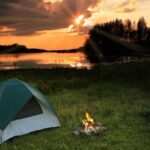by Liz Childers
“When in survival situations, being able to navigate your way out of the woods or even through the wreckage of a town is an essential skill. That’s why all survival kits should be packed with a GPS and a compass – in case the GPS breaks. But with the chance that you could be thrown into survival conditions without your kit, you should know how to find directions without the help of technology. Nature provides us with many directional aides; you just need to know how to interpret them.
Erik Falk, an adventure lover since his childhood, is passionate about exploring the wilderness. His site, Wilderness Survival Skills, is an incredibly helpful account of all the survival knowledge he has gained over the years. Mr. Falk shared with us tips on finding directions by using nature.
Finding Directions Using the Sun
The sun is the most basic means of natural navigation. The sun rises in the east and sets in the west – roughly. Therefore, at 6 a.m., the sun is due east; at 6 p.m., the sun is due west. At midday, the sun is due south if you are in the Northern Hemisphere and due north if you are in the Southern Hemisphere.
An analog watch can help you find north and south, as well. If you are in the Northern Hemisphere, point the hour hand of the watch at the sun. Bisect the angle between the hour hand and “12;” this is your north-south line. If you are in the Southern Hemisphere, point the “12” towards the sun and, again, bisect the angle between the “12” and the hour hand.
Mr. Falk points out that this method works best when used at noon between latitudes 40° and 60° north or south of the Equator. Also, your watch must be set accurately to local time.
Finding Directions Using the Moon
To determine South-North directions, here’s a trick that works for half of the month – specifically, if the moon is in a crescent phase. Draw an imaginary line from the two points of the crescent down to the horizon line. The point where the two lines meet is south for the Northern Hemisphere and north for the Southern Hemisphere.
For East-West directions, pay attention to the direction the moon is facing. If the moon rises before the sun sets, the illuminated side is facing west. So if you are looking at the moon in this situation, you are looking east. If the moon rises after midnight, the illuminated side is facing east. This means you are looking west when you face the moon.
Finding Directions Using the Stars
Both hemispheres have celestial marking to help you find north or south. In the Northern Hemisphere, the North Star is very close to the exact location of the north celestial pole and is in a fixed position throughout the night. To find it, locate the Big Dipper. Mr. Falk says a good rule of thumb is to count 5x the length of the edge of the dipper’s cup to a medium bright star. This is the North Star. You can also use Cassiopeia, a trapezoid shaped constellation, as the North Star is located halfway between it and the Big Dipper.
The Southern Cross is a fixed constellation that appears to rotate around the Southern Celestial Pole. There are five stars in the constellation: the four main stars of the cross and a smaller star in between two of the others. Locate the constellation. Drawing an imaginary line from the star at the top of the cross through the star that forms the left end of the short arm of the cross, you will find the two bright pointer stars. To find south, draw an imaginary line going from the top star of the cross through the bottom star; now draw a perpendicular line from the midway point of the two pointer stars. The point where these two lines intersects is the Southern Celestial Pole.
A good tip from Mr. Falk is to draw an arrow in the dirt marking the direction of the celestial pole, so you’ll still know where north or south is in daylight.
Reminders
Mr. Falk reminds us that these methods only give a general direction. However, combined, they can help you find a fairly true direction. But remember: even when you know these methods, don’t leave home for a camping trip without your compass or GPS.”



